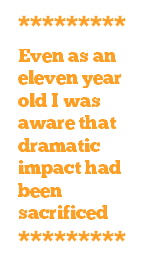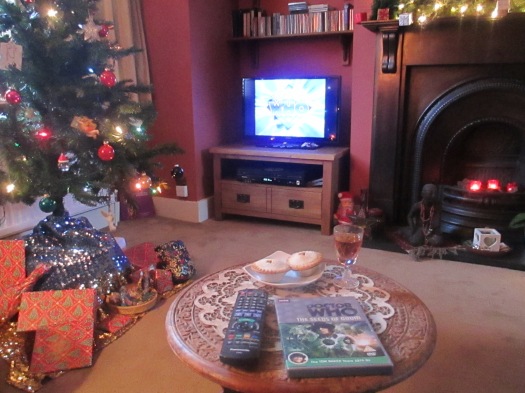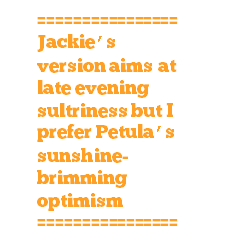10 episodes, Original tx. Jan-Mar 1975, 5.20-5.45pm, BBC-1
A well remembered and ground-breaking children’s drama series emerges from the mists of the mid-70s into 2014 and onto DVD. This is what ‘The Changes’ means to me now and what it meant back then.
Embed from Getty Images
World’s End Housing Estate, January 1975
1975
I was nearly eleven when The Changes was first broadcast in January 1975. It was a pertinent age to view the series as it prefigured major changes in my life that year.
1975 was the year I moved from a cosy village school to a huge comprehensive. Almost simultaneously, my parents left the comfortable, airy 60s detached house of my childhood and bought an older building which needed a lot of repair, making it feel exposed, unhomely and, crucially, pre-modern.
The series unfolds not just as Nicky’s search for the origin of The Changes but as her own journey from child to adolescent. It was a journey I was not yet ready to make in January 1975. But as the year advanced, I had a sense of stepping into a harsher, less sheltered world, underscored by my growing awareness of the sort of issues tackled by The Changes. By the end of 1975 I was forced to leave childish things behind as a premature adolescence began. The sombre feel of The Changes prefigures the depressive mood of my teenage years and their search for meaning and identity.
‘A series for older viewers’
I am sure I recall the pre and post-John Craven’s Newsround warning of unusually adult content in the forthcoming programme at 5.20, as that sort of message would definitely have made me prick up my ears. I couldn’t have guessed at how visceral and violent that content was to be.
Episode One’s opening scene is one of domestic familiarity – schoolgirl Nicky Gore does her homework with the television on in the background while her mother sits knitting and father reads the paper. Then, from nowhere and everywhere, the angry ‘noise’ begins, prompting Nicky’s father, involuntarily, to smash the television. It is hard to express how shocking, how terrifying was that sudden and inexplicable act of savagery in a suburban living room, witnessed in my own suburban living room back in 1975.
This single act leads into an orgy of mass destruction taking place across Britain, apparently caused by the noise compelling people to destroy machinery. The scenes of electrical appliances and even bicycles dragged onto streets and smashed up alongside burning cars, were – and still are – incredibly disturbing. The series talks openly about many people left to die and we see Nicky forced to leave an old man in a doorway to fend for himself. A thin veneer of civilisation is stripped away literally overnight as Britain is cast back into a pre-industrial age.
I don’t think I had seen anything so unsettling on television, carrying such an air of urgent threat perhaps since the apocalyptic Dr Who story Inferno almost five years earlier. The sense of dislocation, panic and utter fear is palpable.
Parallel worlds
What was depicted in that first episode built upon my semi-conscious awareness of growing discontent in the adult world around me, a world of sudden power-cuts, energy conservation campaigns (‘Save It!’) and constant scenes of industrial conflict on the television news. What I was experiencing was a child’s view of the breakdown of the post-war consensus and the very uncertainty of society itself. The Changes also bore disturbing parallels with the notion of a post holocaust Britain, at a time when I was becoming aware of the cold war and nuclear threats.
Seen now, it is as if what we are looking at is an alternative view of Britain, an extreme form of what might have come about if industrial decline had continued apace and instead of being propelled into a world of Thatcherite conspicuous consumption and an economy driven by global financial services, Britain reverted to a kind of isolated communitarian/agrarian republic, overall poorer yet potentially more egalitarian and with a distinctly land-based local identify, too fragmented to be called patriotic. In other words, a wholesale rejection of consumer capitalism and all that has come to be seen as ‘modernity’. This perhaps seems fanciful in an age of 24/7 electronic media saturation and near global capitalism but would not have seemed so to Britain ‘managing decline’ in the mid-70s.
When Anna Home came to adapt Peter Dickinson’s trilogy – The Weathermonger, Heartsease, The Devil’s Children – she inserted this pre-Changes opening episode to allow the full force of what follows to have maximum impact.
‘Devil’s Children’
Nicky and her parents try to escape to France but she becomes separated from them amidst the chaos of the city streets. Compelled to make her own way, she chances across a small band of travelling Sikhs and joins them.
It took me a while to accept this turn of the story as a child, as, at first, it seemed insufficiently connected to what had gone before. In retrospect, as a ten year old, I was probably a little young for the programme’s target audience and wanted episode one’s explicit sense of drama and threat to continue, if not heighten. I can appreciate the subsequent episodes more now than then.
The sensitive and overwhelmingly positive portrayal of the Sikhs – the contrast between Nicky’s can-do feminist individualism and the Sikh’s deferential traditionalism – is an unusually forward-thinking aspect of the series at a time when British television sitcoms were awash with crude cultural stereotypes. The series shows how genuine understanding, respect and affection can be established across racial, cultural and religious divides. But The Changes never wears its liberal, feminist, multiethnic and environmentalist credentials on its sleeve and does not feel patronising in its portrayal of race and culture. Nicky encounters and adjusts to this new world and we do so with her.
It seems extraordinary that it took a series for children to ask whether a minority community can thrive in a ‘host’ country (the debate was still framed in this way then) and show how this might look.
‘Wicked and dangerous’
Racism, misogyny and suspicion rear their ugly heads as a kind of neo-feudalism takes over the land. Machines become synonymous with ‘wickedness’, outsiders and dissenters branded as ‘evil.’ Nicky herself is put on trial as a witch and faces death by stoning. The series seems to be making a critique of dangerously inward-looking tribal religiosity, one which is entirely white and male dominated.
As The Changes is shot entirely on film and on location, it benefits from an immediacy which studiobound drama of the time often lacks. It is essential that what we are seeing looks and feels like ‘the real world’ and indeed it does. Only occasionally do we drift slightly into children’s drama cliché – the choreographed fight sequences in episode five and the exaggerated baddie acting of the black bearded robber chief are cases in point. Other characters, such as Arthur Barnard the bigoted farmer turned quasi-squire, impart a genuine sense of brutish ignorance and menace.
There are very few special effects overall, bar a mind-bending, colour saturated sequence and kaleidoscopic review of key scenes in Episode Ten and the series doesn’t demand them. Its unflashiness is one of its great virtues.
I like the fact that it is not afraid to adopt a lighter tone and a leisurely pace at times. This gives a greater sense of ‘real time’ unfolding and of the slower feel to life following The Changes. It accentuates the role that the land itself plays in the drama – the changing landscape of river, farmland, woodland and forest. It’s possible to see the middle episodes of The Changes as some kind of English, ruralist road movie with Vicky’s journey becoming less and less connected with the modern and the urban and more and more with the past, the land and, eventually, a mythical England.
The Noise
Embed from Getty Images
Bad wires: The noise seems to travel along power-lines
Paddy Kingsland’s synth/electric guitar dominated incidental music (with sitar and tabla for the episodes featuring the Sikhs) gives the series a great deal of ruralist medievalist/70s atmosphere. There is perhaps a little too much music at times, particularly in some of the earlier episodes (the overuse of the same theme in different keys at the start of Episode Four grates a little) but there are also some lovely and most evocative passages such as Episode Nine’s horseback ride which is beautifully shot too.
In the DVD booklet, Paddy Kingsland’s recalls almost smashing up his Delaware synthesiser to create the noise. The result is chillingly effective, a little like running a pencil over piano strings with the sustain pedal held down whilst holding your head in the instrument’s cavity so that you are both surrounded by the swirling sound and feeling its resonance inside your head – only ten times as terrifying.
The unusual option to include different music for start and end titles works very well, underlying the before and after worlds and with an apt musical amalgam of the two at the story’s conclusion. The opening theme uses tabla and synth to convey – in a 70s funk kind of way – the fast pace of modern, urban life, then giving way to the noise and a sense of disintegration. The trumpet/horns dominated end theme hints at something medieval and magisterial, yet timeless. It has a kind of foreboding, understated grandeur.
I also like the device of actually showing the scene of the story’s climax – the mysterious standing stone in a quarry cavern – as the closing titles’ backdrop to all ten episodes, so that as each episode advances we have the sense of moving another step closer towards this ending, the source of The Changes. The imagery forms a totally unexpected end to Episode One, intrigues us by Episode Seven, and begins to make sense by episode Eight or Nine.
The voice of the ‘thing’ is masterfully realised – the sound of something ancient, unknown and unknowable, hidden from us yet conveying a sense of great latent power and elemental emotion which threatens to burst forth in full fury at any moment – infinitely more effective than standard alien monotone sci-fi voices.
Merlin myth
I am not sure how I feel about the eventual resolution lying in myth and legend. In some ways, the largely unexplained magical ending seems like a kind of retreat from the hard-edged nature of what has gone before. On the other hand, it embeds the series’ radical social/political agenda in wider, deeper notions of time, place, continuity, freedom and change as well as myth, legend and the unexplained.
Nicky’s confronting the thing has echoes of 1971 Doctor Who story The Dæmons, in which another spirited but defenceless female (Jo Grant) risks all to confront an immense source of power in mythological form and in so doing, a threat to the world is averted. Another parallel with The Dæmons is Nicky’s conversation with Jonathan as the industrial world returns, in which she reflects that human-beings must be free to make their own mistakes, decide their own futures, even if those decisions may seem dangerous and wrong.
This ending seems to express an optimism that an innate balance can be found. Perhaps that is ultimately what The Changes is about – balance and equanimity.
Over time
Such has been the rapid pace of technological change over the last forty years that a pre-Changes world of 1975 probably feels to us, or certainly our children, almost medieval in its crudeness. It’s strange to think that I lived through that ‘medievalism’.
The Changes remains an ambitious, challenging and highly original piece of television. The further away we move from the mid-70s, the more clearly I see how The Changes draws upon many themes of the time, themes I was only dimly aware of as a ten year old. Those same themes – environmentalism, multiculturalism, racism – and The Changes itself, remain as pertinent today as nearly forty years ago.
Don’t be put off by the early-web appearance of Tony Gosling’s Bilderberg.com as this site as it is an excellent resource on The Changes. In fact, its primitivism seems oddly fitting.
Robin Carmody’s essay is a passionate and insightful appreciation of The Changes.
The Changes DVD Review
 Were garden birds so different back in the 60s and 70s? A blackbird in 2017 seems pretty much the same as a blackbird in 1977 (or my memory of one) though an ornithologist may well beg to differ.
Were garden birds so different back in the 60s and 70s? A blackbird in 2017 seems pretty much the same as a blackbird in 1977 (or my memory of one) though an ornithologist may well beg to differ.
 On to 1975, and Birds in Autumn & Winter is graced with a Tunnicliffe illustrated cover albeit without the decorative background detail which makes the BB cards so lustrous.
On to 1975, and Birds in Autumn & Winter is graced with a Tunnicliffe illustrated cover albeit without the decorative background detail which makes the BB cards so lustrous.





 era of Dr Who begins. “Tears, Sarah Jane?” I’m sure I shed some of my own as my familiar white-haired hero was transformed before my eyes into a brown curly-haired stranger for a no less traumatic second time.
era of Dr Who begins. “Tears, Sarah Jane?” I’m sure I shed some of my own as my familiar white-haired hero was transformed before my eyes into a brown curly-haired stranger for a no less traumatic second time.
 felt less than entirely satisfied.
felt less than entirely satisfied.
 themselves as obvious high calibre candidates. I struggle once we reach The Invasion of Time (1978) and The Armageddon Factor (1979) admittedly.
themselves as obvious high calibre candidates. I struggle once we reach The Invasion of Time (1978) and The Armageddon Factor (1979) admittedly.

 This is what happened when I moved aged eleven in 1975. I didn’t want us to move and remember scowling with hate-filled venom as my parents showed prospective buyers around. I thought my fixed, silent, demonic stare might somehow ward them off. It didn’t work, at least, not with Mr & Mrs Hunter and their curly-haired twin boys. They even had the audacity to arrive just as Terror of the Zygons reached its climax.
This is what happened when I moved aged eleven in 1975. I didn’t want us to move and remember scowling with hate-filled venom as my parents showed prospective buyers around. I thought my fixed, silent, demonic stare might somehow ward them off. It didn’t work, at least, not with Mr & Mrs Hunter and their curly-haired twin boys. They even had the audacity to arrive just as Terror of the Zygons reached its climax. its place was an austere 1950s, metal windowed house with an asbestos garage and mean little prefab outhouse. It wasn’t so far away from our old house but might as well have been a million miles.
its place was an austere 1950s, metal windowed house with an asbestos garage and mean little prefab outhouse. It wasn’t so far away from our old house but might as well have been a million miles. disaffection had not just been sewn but were already growing up around me in my final two terms at primary school. A childhood culture of vim and vigour was giving way to a disaffection amongst the more precocious children. I can see how hopeless I was at football, how removed from the rough and tumble of most boys’ activities as I stayed on the sidelines with a few close friends. I can see how setup I was to fall.
disaffection had not just been sewn but were already growing up around me in my final two terms at primary school. A childhood culture of vim and vigour was giving way to a disaffection amongst the more precocious children. I can see how hopeless I was at football, how removed from the rough and tumble of most boys’ activities as I stayed on the sidelines with a few close friends. I can see how setup I was to fall.

 more likely, no one actually got my messages. Email addresses have probably changed half a dozen times since joining fifteen years ago. I really should have plunged head-in when the phenomenon was at its height back in those I ♥ the days of the early noughties (Friends Reunited was as much a product of new millennial nostalgia as it was a particular evolutionary stage of the internet).
more likely, no one actually got my messages. Email addresses have probably changed half a dozen times since joining fifteen years ago. I really should have plunged head-in when the phenomenon was at its height back in those I ♥ the days of the early noughties (Friends Reunited was as much a product of new millennial nostalgia as it was a particular evolutionary stage of the internet). last ten, twenty of forty years, why would you want to make return visits to people who vanished from your life decades ago, very possibly for good reasons?
last ten, twenty of forty years, why would you want to make return visits to people who vanished from your life decades ago, very possibly for good reasons? being called together and the cheery press photographer coming to snap us that freezing February lunch-hour. The future of the Victorian village school was uncertain then though it still stands today, apparently thriving, albeit no longer as a C of E school.
being called together and the cheery press photographer coming to snap us that freezing February lunch-hour. The future of the Victorian village school was uncertain then though it still stands today, apparently thriving, albeit no longer as a C of E school.
 harder edge to Jackie’s voice in places.
harder edge to Jackie’s voice in places. Then there was Laurie Johnson’s doom laden opening music – creepy woodwind and those dreaded dissonant ‘ker-drrrrmmm!’ harpsichord stings accompanying a blood red framed, fish-eyed view of the locations to come – a forbidding old house (often with pillars) or bare trees clawing at a wintry sky.
Then there was Laurie Johnson’s doom laden opening music – creepy woodwind and those dreaded dissonant ‘ker-drrrrmmm!’ harpsichord stings accompanying a blood red framed, fish-eyed view of the locations to come – a forbidding old house (often with pillars) or bare trees clawing at a wintry sky. You can enjoy the sense of manipulation when it’s in the name of suspense – and suspense, Thriller delivers in spade-loads.
You can enjoy the sense of manipulation when it’s in the name of suspense – and suspense, Thriller delivers in spade-loads.